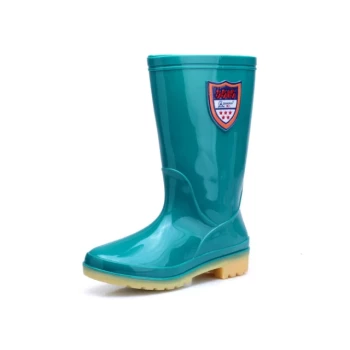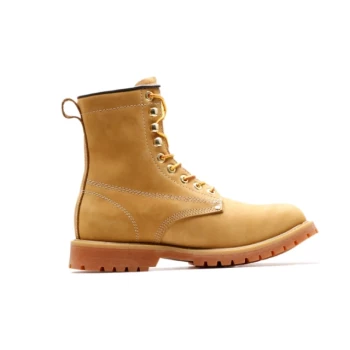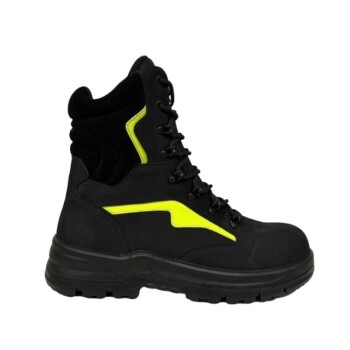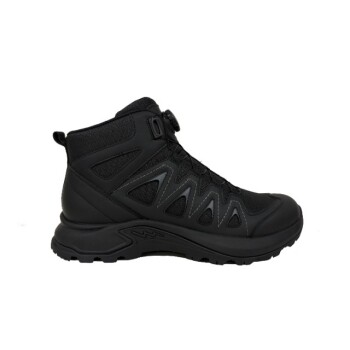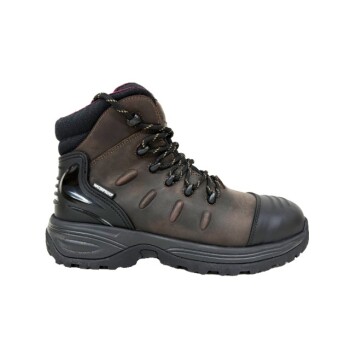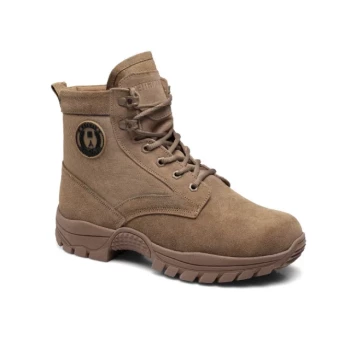For agricultural work, your boots must provide a comprehensive defense against your environment. The most recommended features are reinforced safety toes, puncture-resistant and high-traction outsoles, waterproofing, and robust ankle support to handle the unique hazards of farm life.
The right agricultural boot isn't simply the one with the most features; it's the one with the precise combination of protection, durability, and comfort that directly matches the specific tasks and conditions of your farm.
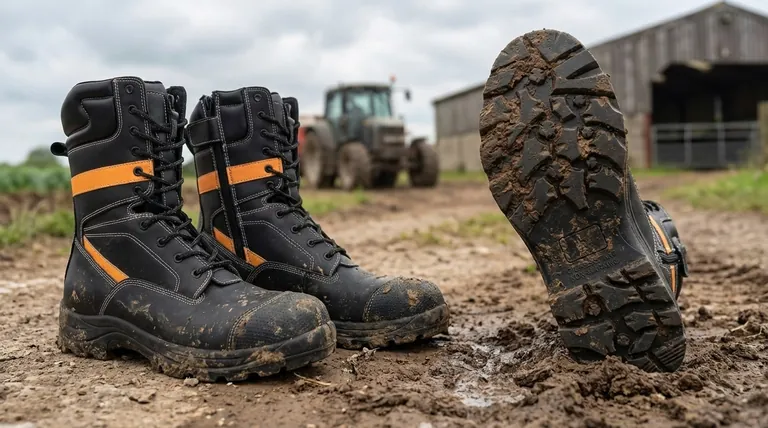
Core Elements: Protection and Stability
Your boots are the primary line of defense for your feet. Their construction must prioritize safety and a stable foundation for working long hours on unpredictable ground.
Reinforced Toe Caps
Safety toes are non-negotiable when working with livestock, heavy equipment, or unwieldy materials. They shield your feet from compression and impact injuries.
You have two main options: steel toes, which offer maximum protection, and composite toes, which are lighter and don't conduct cold, making them a better choice in winter. Both should meet national safety standards.
Puncture-Resistant Midsoles
Farm environments are littered with sharp objects, from broken tools and wire to sharp rocks and stubble. A puncture-resistant plate, often made of steel or a flexible composite material, is embedded in the outsole to prevent these hazards from penetrating the boot.
High-Traction Outsoles
Traction is critical for preventing slips and falls on wet concrete, mud, or uneven fields. Look for boots with deep, aggressive tread patterns (lugs) designed to shed mud and grip slick surfaces effectively.
Ankle and Arch Support
Long days on uneven terrain put immense strain on your feet and joints. Good boots provide substantial ankle support to prevent twists and sprains. Additionally, proper arch support and cushioning are essential for comfort and reducing fatigue.
Shielding Against the Elements
Beyond physical hazards, your boots must protect you from the constant exposure to moisture, chemicals, and temperature extremes inherent in farm work.
The Critical Role of Waterproofing
From morning dew to wash-down stations, moisture is a constant. Waterproof construction is essential for keeping your feet dry, preventing blisters, and maintaining comfort throughout the day.
Chemical Resistance
Farms regularly use pesticides, fertilizers, and other chemicals that can degrade boot materials and pose a health risk. Select boots made from materials specifically rated for chemical resistance to ensure both durability and your safety.
Insulation for Cold Weather
For work in colder climates or seasons, insulated boots are a necessity. Proper insulation helps maintain circulation and prevents cold-related injuries like frostbite, allowing you to work safely and comfortably in low temperatures.
Understanding the Trade-offs
Choosing the perfect boot involves balancing competing features. Understanding these trade-offs is key to selecting a tool that truly works for you.
Protection vs. Weight
Features like steel toes and heavy-duty outsoles add significant protection but also increase the boot's weight. This can lead to fatigue over a long day. Composite materials offer a lighter-weight alternative, though sometimes with a slight compromise in maximum impact resistance.
Waterproofing vs. Breathability
A fully waterproof membrane is excellent at keeping water out, but it can also trap sweat and heat inside, especially in warm weather. For hotter, drier climates, you might prioritize a more breathable (but less waterproof) boot to manage moisture from the inside out.
The Importance of a Proper Fit
Even the most feature-rich boot is useless if it doesn't fit correctly. A boot that is too tight can cause blisters and restrict circulation, while a boot that is too loose won't provide adequate support. Always ensure a snug but comfortable fit with an adjustable fastening system.
Making the Right Choice for Your Farm
Select your boots based on the most common hazards and conditions you face daily.
- If your primary focus is livestock and dairy operations: Prioritize waterproofing, chemical resistance, and an aggressive, slip-resistant sole for wet concrete.
- If your primary focus is fieldwork with heavy machinery: Emphasize a certified safety toe, puncture resistance, and excellent ankle support.
- If your primary focus is working in variable climates: Consider owning two pairs—an insulated, waterproof boot for winter and a lighter, more breathable one for summer.
Investing in the right pair of boots is a direct investment in your daily safety, comfort, and productivity.
Summary Table:
| Key Feature | Primary Benefit | Best For |
|---|---|---|
| Reinforced Toe Caps | Protects from impact and compression | Livestock, heavy machinery |
| Puncture-Resistant Midsoles | Shields feet from sharp objects | Fieldwork, rough terrain |
| Waterproof Construction | Keeps feet dry in wet conditions | Dairy operations, muddy fields |
| High-Traction Outsoles | Prevents slips and falls | Slick surfaces, uneven ground |
| Ankle & Arch Support | Reduces fatigue, prevents injuries | Long hours on feet |
Ready to Equip Your Team with the Right Protection?
As a large-scale manufacturer, 3515 produces a comprehensive range of durable and safety-compliant footwear for distributors, brand owners, and bulk clients. Our production capabilities encompass all types of agricultural boots and work shoes designed to meet the specific demands of farm life.
We can help you source or customize the perfect boots to keep your workforce safe, comfortable, and productive. Contact our experts today to discuss your needs and get a quote!
Visual Guide
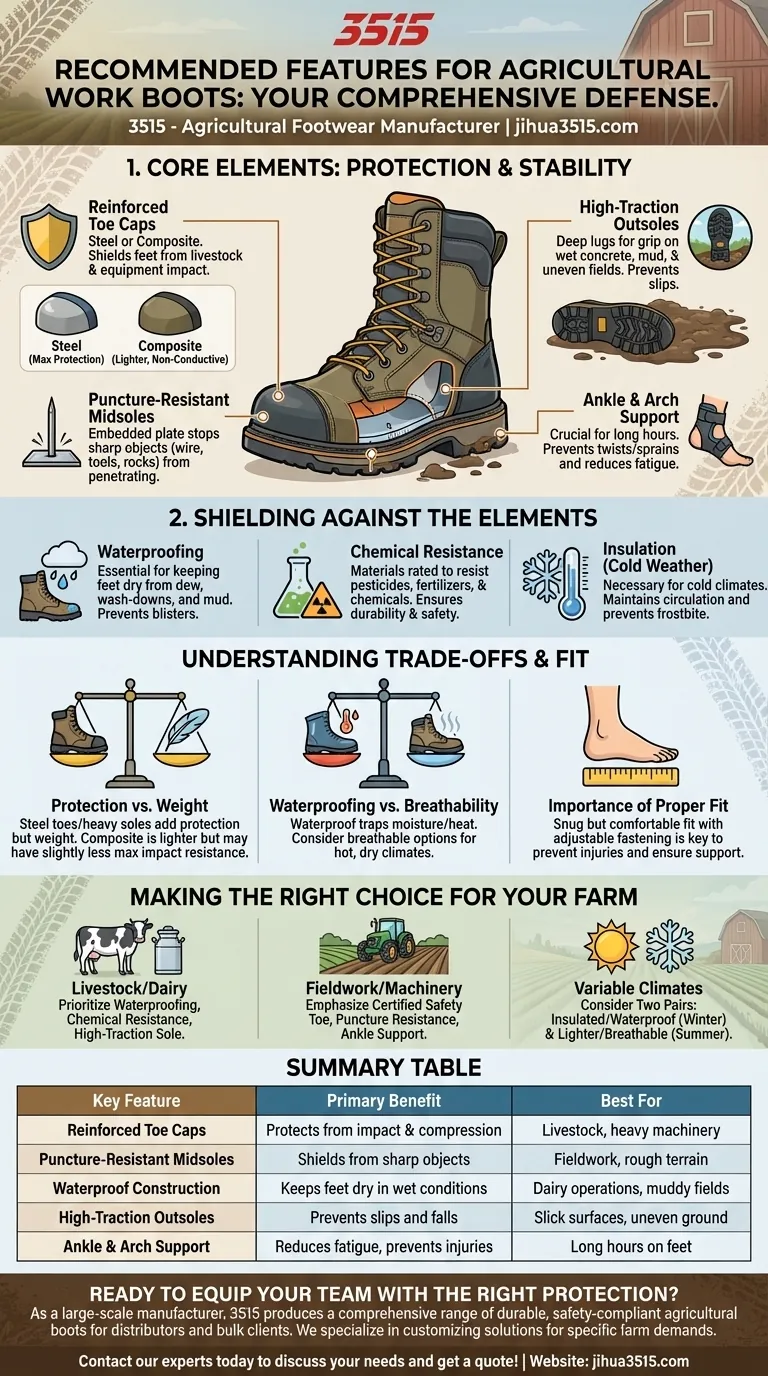
Related Products
- Premium Flame-Retardant Waterproof Safety Boots and Shoes
- High Performance Fire-Retardant Waterproof Safety Boots
- Puncture-Resistant Velcro Safety Boots for Wholesale & Custom Manufacturing
- Premium High-Cut Waterproof Safety Boots Manufacturing & Wholesale Solutions
- Premium Wholesale Waterproof Safety Boots High Performance Protection for Industrial Markets
People Also Ask
- How do some boots combine materials for better performance? Achieve Superior Safety & Comfort
- What is the importance of safety footwear in various industries? Essential Protection for Your Workforce
- What potential foot injury hazards exist in workplaces? A Guide to Mitigating Common Risks
- What are the benefits of proper safety footwear beyond physical protection? Boost Productivity & Morale
- How does repeated exposure to high temperatures damage safety boots? Avoid Costly Structural Failures









